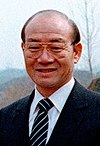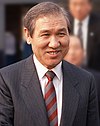Democratic Justice Party
This article needs additional citations for verification. (January 2013) |
Democratic Justice Party 민주정의당 Minju Jeonguidang | |
|---|---|
 Former South Korean Party | |
| Leader | Roh Tae-woo (1985-1990) |
| Founder | Chun Doo-hwan |
| Founded | 15 January 1981 |
| Dissolved | 22 January 1990 |
| Preceded by | Democratic Republican Party |
| Merged into | Democratic Liberal Party |
| Headquarters | Seoul, South Korea |
| Ideology | National conservatism Korean nationalism Anti-communism Neoliberalism Authoritarianism (until 1987) |
| Political position | Far-right (until 1987)[1] Right-wing (from 1987)[2] |
| National affiliation | Hanahoe |
| Colours | Blue and Red (until 1987) Light Blue and Red (from 1987) |
| Democratic Justice Party | |
| Hangul | 민주정의당 |
|---|---|
| Hanja | 民主正義黨 |
| Revised Romanization | Minju Jeong-uidang |
| McCune–Reischauer | Minju Chŏng-ŭitang |
| DJP | |
| Hangul | 민정당 |
| Hanja | 民正黨 |
| Revised Romanization | Minjeongdang |
| McCune–Reischauer | Minchŏngtang |
| Part of a series on |
| Conservatism in South Korea |
|---|
|
|
The Democratic Justice Party (DJP) (민주정의당) was the ruling party of South Korea from 1981 to 1988.
History
Chun had become the country's de facto leader after leading a military coup in December 1979, and was elected president in his own right in August 1980. Two months after taking office, he abolished all political parties, including Park Chung-hee's Democratic Republican Party, which had ruled the country since 1963, and with few viable constraints on its power since Park's self-coup of 1971. A new Constitution, which inaugurated the Fifth Republic, was enacted later in October.
The following January, Chun created the Democratic Justice Party, which garnered the support of most DRP lawmakers and politicians; for all intents and purposes it was the DRP under a new name. He was elected as the first president of the Fifth Republic in 1981. Although the DJP won large majorities at legislative elections in 1981 and 1985 and the system was heavily rigged in its favor, it had far less power than the DRP.
The 1980 Constitution limited the president to a single seven-year term, with no possibility of reelection. Chun announced his retirement in 1987, but resisted all calls to further open up the regime. The situation changed later in 1987, when DJP presidential candidate Roh Tae-woo promised that year's presidential election would be free and democratic. Roh became the first direct elected president under free and fair election in December 1987. In 1990, the DJP merged with Kim Young Sam's Reunification Democratic Party and Kim Jong-pil's New Democratic Republican Party to form the Democratic Liberal Party.
See also
- Hanahoe - Most of DJP's key figures were from the far-right military organization Hanahoe.
Election results
Presidential elections
| Election | Candidate | Total votes | Share of votes | Outcome | |
|---|---|---|---|---|---|
| 1981 | Chun Doo-hwan | 
|
4,755 (electoral vote) | 90.2% | Elected |
| 1987 | Roh Tae-woo | 
|
8,282,738 | 36.6% (direct election) | Elected |
Legislative elections
| Election | Total seats won | Total votes | Share of votes | Outcome of election | Election leader |
|---|---|---|---|---|---|
| 1981 | 151 / 276
|
5,776,624 | 35.6% | Chun Doo-hwan | |
| 1985 | 148 / 276
|
7,040,811 | 34.0% | Chun Doo-hwan | |
| 1988 | 125 / 299
|
6,675,494 | 34.0% | Roh Tae-woo |
References
- Pages with short description
- Articles with short description
- Short description with empty Wikidata description
- Articles needing additional references from January 2013
- All articles needing additional references
- Articles containing Korean-language text
- AC with 0 elements
- Conservative parties in South Korea
- Defunct political parties in South Korea
- National conservative parties
- Far-right politics in South Korea
- Political parties established in 1980
- Political parties disestablished in 1990
- Liberty Korea Party
- Neoliberal parties
- 1980 establishments in South Korea
- 1990 disestablishments in South Korea
- Right-wing parties
- Right-wing politics in South Korea